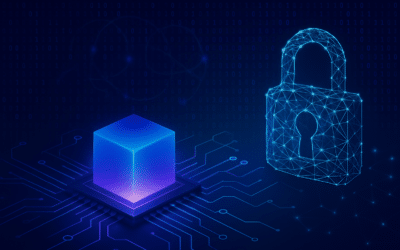Quantum...
Securing IoT Devices and Networks
Internet of Things (IoT) Security: Protecting the Connected World
In today’s rapidly evolving digital landscape, the Internet of Things (IoT) has become an integral part of our daily lives. From smart homes to industrial automation, IoT devices are revolutionizing the way we interact with technology. However, as the number of connected devices grows exponentially, so do the security risks associated with them. This blog post will explore the critical aspects of IoT security, including how to connect IoT devices safely, the importance of Internet of Things monitoring, and the significance of recognizing Internet of Things icons for better security awareness.
Understanding IoT Security Challenges
Before delving into security measures, it’s crucial to understand the unique challenges posed by IoT devices:
1. Diverse Ecosystem: IoT encompasses a wide range of devices with varying capabilities, making it difficult to implement uniform security measures.
2. Limited Resources: Many IoT devices have constrained processing power and memory, limiting their ability to run complex security protocols.
3. Widespread Connectivity: The sheer number of connected devices increases the attack surface for potential cybercriminals.
4. Data Privacy Concerns: IoT devices often collect and transmit sensitive personal data, raising privacy issues.
5. Lack of Standardization: The absence of universal IoT security standards complicates the implementation of consistent security practices.
How to Connect IoT Devices Securely
Connecting IoT devices to your network is the first step in your IoT journey, but it’s crucial to do so securely. Here are some best practices for how to connect IoT devices safely:
1. Secure Network Configuration
– Use a separate network or VLAN for IoT devices to isolate them from your main network.
– Enable WPA3 encryption on your Wi-Fi network to protect against unauthorized access.
– Implement strong, unique passwords for each device and change them regularly.
2. Device Authentication
– Use two-factor authentication (2FA) whenever possible.
– Implement certificate-based authentication for more robust security.
– Utilize biometric authentication for IoT devices that support it.
3. Firmware Updates
– Regularly check for and install firmware updates to patch security vulnerabilities.
– Enable automatic updates when available to ensure timely protection.
– Consider devices from manufacturers with a strong track record of providing timely security updates.
4. Disable Unnecessary Features
– Turn off any features or services that are not essential for the device’s primary function.
– Close unused ports to reduce potential entry points for attackers.
5. Use VPNs for Remote Access
– When accessing IoT devices remotely, use a Virtual Private Network (VPN) to encrypt communications.
– Implement VPN solutions that are compatible with your IoT ecosystem.
The Importance of Internet of Things Monitoring
Internet of Things monitoring is a critical component of maintaining a secure IoT ecosystem. Effective monitoring helps detect anomalies, prevent breaches, and ensure optimal performance. Here’s why it’s essential:
1. Real-time Threat Detection
Continuous monitoring allows for the immediate identification of suspicious activities or potential security breaches. By analyzing device behavior and network traffic patterns, you can quickly spot and respond to threats before they escalate.
2. Performance Optimization
Monitoring helps identify performance issues, such as device malfunctions or network bottlenecks. This information is crucial for maintaining the efficiency and reliability of your IoT infrastructure.
3. Compliance Management
Many industries have specific regulations governing IoT device usage and data handling. Robust monitoring helps ensure compliance with these standards and facilitates auditing processes.
4. Predictive Maintenance
By monitoring device health and performance metrics, you can predict when maintenance is needed, reducing downtime and extending the lifespan of your IoT devices.
5. Data Analytics
Monitoring generates valuable data that can be analyzed to gain insights into device usage patterns, user behavior, and system performance. This information can drive informed decision-making and improvements in your IoT strategy.
Implementing Effective IoT Monitoring
To implement effective Internet of Things monitoring, consider the following steps:
1. Choose the Right Monitoring Tools: Select monitoring solutions that are compatible with your IoT ecosystem and offer comprehensive visibility across all devices and networks.
2. Establish Baselines: Define normal behavior patterns for your IoT devices to more easily identify deviations that could indicate security issues.
3. Set Up Alerts: Configure alerts for specific events or thresholds that require immediate attention, such as unauthorized access attempts or abnormal data transmission patterns.
4. Regular Audits: Conduct periodic security audits to assess the effectiveness of your monitoring system and identify areas for improvement.
5. Integrate with SIEM: Consider integrating your IoT monitoring with a Security Information and Event Management (SIEM) system for more comprehensive threat analysis and response.

Interested in becoming a student?
Look for your passion in our available programs
The Role of Internet of Things Icons in Security Awareness
Visual cues play a significant role in raising security awareness among users and administrators. **Internet of Things icons** can serve as quick, recognizable symbols that convey important information about device status, security levels, and potential risks. Here’s how these icons can enhance IoT security:
1. Device Identification
Unique icons for different types of IoT devices help users and administrators quickly identify and categorize connected devices within their network.
2. Security Status Indicators
Color-coded icons can indicate the current security status of a device, such as green for security, yellow for potential issues, and red for immediate security concerns.
3. Update Notifications
Specific icons can be used to notify users when firmware updates are available or when a device requires attention due to security vulnerabilities.
4. Access Control Visualization
Icons can represent different levels of access control, helping users understand which devices have restricted access and which are more openly accessible.
5. Data Privacy Indicators
Specialized icons can indicate the type and sensitivity of data being collected or transmitted by IoT devices, promoting transparency and user awareness.
Best Practices for IoT Security
To wrap up our discussion on IoT security, here are some overarching best practices to implement:
1. Implement a Zero Trust Model: Treat all devices and network connections as potentially compromised, requiring continuous verification.
2. Use Encryption: Encrypt data both in transit and at rest to protect sensitive information from unauthorized access.
3. Regular Security Assessments: Conduct frequent vulnerability assessments and penetration testing to identify and address security weaknesses.
4. Employee Training: Educate employees about IoT security risks and best practices to minimize human error-related vulnerabilities.
5. Incident Response Plan: Develop and regularly update an incident response plan specifically tailored to IoT-related security breaches.
6. Vendor Security Evaluation: Carefully assess the security practices of IoT device manufacturers and service providers before integrating their products into your ecosystem.
7. Data Minimization: Collect and store only the data necessary for device functionality to reduce the potential impact of data breaches.
8. Physical Security: Implement physical security measures to protect IoT devices from tampering or unauthorized access.
Conclusion
As the Internet of Things continues to expand, securing this vast network of connected devices becomes increasingly crucial. By understanding how to connect IoT devices securely, implementing robust **Internet of Things monitoring** systems, and leveraging Internet of Things icons for enhanced awareness, organizations and individuals can significantly improve their IoT security posture.
Remember, IoT security is an ongoing process that requires constant vigilance, adaptation, and improvement. Stay informed about the latest security threats and best practices, and regularly reassess your IoT security strategy to ensure it remains effective in the face of evolving challenges. By prioritizing security in your IoT implementations, you can harness the full potential of connected devices while minimizing the associated risks.
Become a student at Atlantis University
Related Posts
Digital Transformation Certificate for Future Leaders 2025
Explore our...
Sports Media Career: 10 Powerful Reasons to Get Started Today
Discover 10...
Human Intelligence Augmented by Artificial Intelligence – The Only Viable Path for Humanity in 2025
Human...
What’s Driving the Powerful Bahamas Tourism Industry in 2025
Explore how...
10 Powerful Reasons Norwegian Cruise Line Careers Offer Exceptional
Norwegian...










